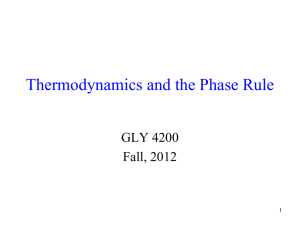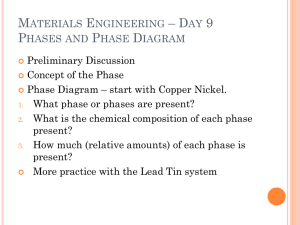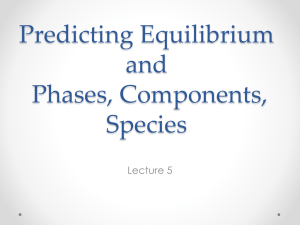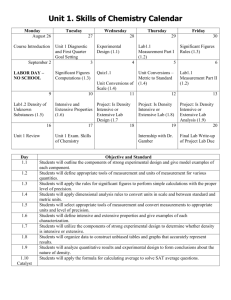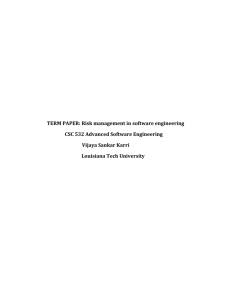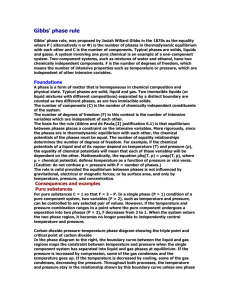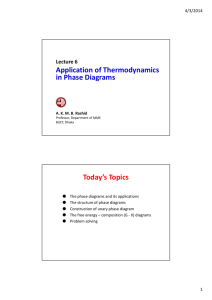pubdoc_12_1690_5018
advertisement
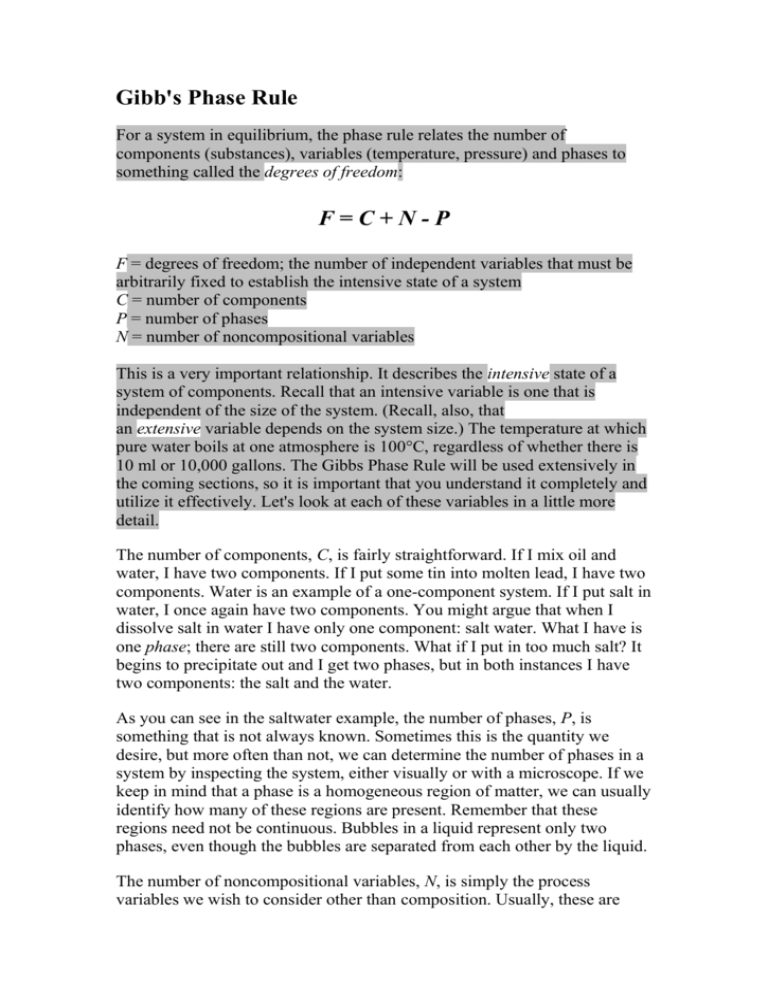
Gibb's Phase Rule For a system in equilibrium, the phase rule relates the number of components (substances), variables (temperature, pressure) and phases to something called the degrees of freedom: F=C+N-P F = degrees of freedom; the number of independent variables that must be arbitrarily fixed to establish the intensive state of a system C = number of components P = number of phases N = number of noncompositional variables This is a very important relationship. It describes the intensive state of a system of components. Recall that an intensive variable is one that is independent of the size of the system. (Recall, also, that an extensive variable depends on the system size.) The temperature at which pure water boils at one atmosphere is 100°C, regardless of whether there is 10 ml or 10,000 gallons. The Gibbs Phase Rule will be used extensively in the coming sections, so it is important that you understand it completely and utilize it effectively. Let's look at each of these variables in a little more detail. The number of components, C, is fairly straightforward. If I mix oil and water, I have two components. If I put some tin into molten lead, I have two components. Water is an example of a one-component system. If I put salt in water, I once again have two components. You might argue that when I dissolve salt in water I have only one component: salt water. What I have is one phase; there are still two components. What if I put in too much salt? It begins to precipitate out and I get two phases, but in both instances I have two components: the salt and the water. As you can see in the saltwater example, the number of phases, P, is something that is not always known. Sometimes this is the quantity we desire, but more often than not, we can determine the number of phases in a system by inspecting the system, either visually or with a microscope. If we keep in mind that a phase is a homogeneous region of matter, we can usually identify how many of these regions are present. Remember that these regions need not be continuous. Bubbles in a liquid represent only two phases, even though the bubbles are separated from each other by the liquid. The number of noncompositional variables, N, is simply the process variables we wish to consider other than composition. Usually, these are temperature and pressure, so that N=2, but for condensed systems; e.g., two solids, the effect of pressure is often times negligible, so that N can also be 1. The degrees of freedom, F, are difficult to conceptualize. They don't have any physical significance, that is, they don't represent a certain phase, or a process variable. Just as with the other variable in the Gibbs Phase Rule, though, they count the number of something. You can think of the degrees of freedom as counting whatever is left from adding and subtracting the other variables (C, N and P). If F=0, we say the system is invariant. Similarly, we can have monovariant, divariant or trivariant systems for F=1, 2 or 3, respectively. Often times, we wish to determine the degrees of freedom. We know how many components we have, we know how many process variables (noncompositional variables) we wish to vary, and we sometimes know how many phases we have. By determining F, we find out how many of the process variables can be changed independently without affecting the number of phases present. The best way to strengthen your grasp on this concept is to forge ahead with phase diagrams. As the complexity of the diagrams increases, you should see why it is important to know the degrees of freedom for a given system. Types of Phase Diagrams Phase diagrams are a graphical representation of three types of information: 1. number of phases present 2. composition of each phase 3. quantity of each phase Degrees of freedom Consider a system in an equilibrium state. In this state, the system has one or more phases; each phase contains one or more species; and intensive properties such as T, p, and the mole fraction of a species in a phase have definite values. Starting with the system in this state, we can make changes that place the system in a new equilibrium state having the same kinds of phases and the same species, but different values of some of the intensive properties. The number of different independent intensive variables that we may change in this way is the number of degrees of freedom or variance, F, of the system. Clearly, the system remains in equilibrium if we change the amount of a phase without changing its temperature, pressure, or composition. This, however, is the change of an extensive variable and is not counted as a degree of freedom. The phase rule, in the form to be derived, applies to a system that continues to have complete thermal, mechanical, and transfer equilibrium as intensive variables change. This means different phases are not separated by adiabatic or rigid partitions, or by semipermeable or impermeable membranes. Furthermore, every conceivable reaction among the species is either at reaction equilibrium or else is frozen at a fixed advancement during the time period we observe the system. The number of degrees of freedom is the maximum number of intensive properties of the equilibrium system we may independently vary, or fix at arbitrary values, without causing a change in the number and kinds of phases and species. We cannot, of course, change one of these properties to just any value whatever. We are able to vary the value only within a certain finite (sometimes quite narrow) range before a phase disappears or a new one appears. The number of degrees of freedom is also the number of independent intensive variables needed to specify the equilibrium state in all necessary completeness, aside from the amount of each phase. In other words, when we specify values of F different independent intensive variables, then the values of all other intensive variables of the equilibrium state have definite values determined by the physical nature of the system.
